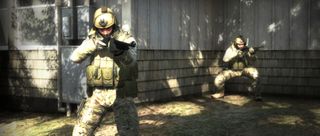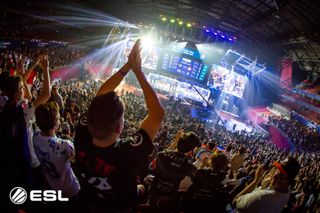The highlights and high-lows of IEM Sydney 2018
A wrap-up of the recent competition and a breakdown of one of the core issues of Counter-Strike: Global Offensive for audiences.

IEM Sydney 2018 wrapped up over the weekend. And while, unfortunately, there wasn’t an Aussie team to be seen in the semifinals and beyond, it wasn’t all bad news. Though the main matches took place between Friday and Sunday, the days (and weeks, if you’re counting the Oceania circuit) leading up to the weekend were filled with qualifying rounds, and Australia was well represented.
Of the sixteen teams competing, Australia had five of them. Yes, that means I’m including expat, US-based Renegades as an Aussie team, but given that they were the only team to make it to the qualifying rounds on Friday, they had a lot of local support going for them. The trick was, during the earlier stages, there was some bad luck in the draw, particularly with Aussie teams squaring off against Aussie teams.
At IEM Sydney 2018, the Chiefs were convincingly beaten by fnatic, 3-16, then again by MVP PK 0-2. Chiefs had a better run during the April Oceania Closed Qualifier, besting Corvidae (2-1), Order (2-0), but losing out to Grayhound (0-2).
Legacy had similar results in the Closed Qualifier, besting Tainted Minds (2-0), Corvidae (2-1), but losing out to Grayhound (0-2) and Order (0-2). During the best-of-three portion of IEM, Legacy had a respectable loss against Renegades (9-16), but were bundled out by fellow Aussies Order in the same numbers as the qualifying rounds (0-2).

Order’s qualifying defeat was the first hard hit. You already know about their loss to the Chiefs and their win against Legacy (above) in the Oceania qualifying rounds, but Order beat Taboo and Tainted Minds 2-0. At IEM, they put up a fight against FaZe, but were ultimately bested 4-16. Order eliminated fellow Aussies Legacy 2-0, but had a close loss against Cloud 9 1-2, in a close finish that could have gone either way. Chris “emagine” Rowlands was still, understandably, disappointed about it the following day when we had a 1v1 battle in CSGO.
Grayhound’s qualifying results are covered above against Chiefs and Legacy (both wins), but they also beat Trident in similar 2-0 fashion. At IEM, Cloud9 bested the local team in a 16-6 win, but Grayhound’s matches with SK and FaZe both went to overtime.
For the quarter finals, that just left Renegades waving the Aussie flag. Like Grayhound and Order, Renegades pushed their matches into overtime. Unlike Grayhound and Order, Renegades proved to be Oceania’s final hope in the quarterfinals. Based in the US, Renegades weren’t part of the Oceania qualifying rounds. As touched on above, Legacy gave them a run for their money in Renegades’ 16-9 win. More impressively, Renegades took down FaZe, the team that’d go on to be the IEM champs, in a solid 2-1 win.
The biggest gaming news, reviews and hardware deals
Keep up to date with the most important stories and the best deals, as picked by the PC Gamer team.
As a viewer, the more concerning thing for me is how parts of CSGO’s competitive format haven’t aged well
Unfortunately, Renegades were beaten 0-2 in their match against TyLoo, but the real heartbreak was the narrow loss against mousesports in overtime, in a 1-2 loss. With all Aussie teams eliminated, IEM had similarly close matches in the semis, with Faze beating TyLoo in overtime 2-1 and Astralis scratching out a win against mousesports in overtime, too: 2-1. While not shown in the final round result, Faze’s surface-level comprehensive 3-0 wipe over Astralis was actually still hard-fought: 19-17 on Cache, 22-20 on Overpass, and 16-14 on Train.
As a viewer, the more concerning thing for me is how parts of CSGO’s competitive format haven’t aged well. I don’t mind the downtime between maps or the initial banning phase. What concerns me is the anti-viewer in-match tactics, and one in particular. Because there’s a round-to-round economy in CSGO, surviving players on the team that’s clearly going to lose are incentivised to hide and hang onto their guns, preserving their team’s firepower in the next round.
While, undoubtedly tense for these players (especially when they’re being hunted to deny their next-round firepower), the emotion doesn’t translate to the audience. What happens, instead, is a consistently predictable point at the end of most rounds where nothing is happening. For instance, the Terrorists have overwhelming numbers after planting the bomb, and the surviving Counter-Terrorists are cowering in a corner to save their firepower and/or utility.
This means the viewer is left watching Terrorists defend a bomb—which isn’t interesting unless it’s contended—and/or a Counter-Terrorist cowering in a corner. It’s not exclusive to this scenario, obviously, but it’s an almost immediate emotional dampener on any emotional high that precedes these moments. And given the viability of the tactic from a player perspective, this particular end-of-round method ain’t going anywhere.
For the well-versed CSGO fan who understands the importance of preserving that AR or AWP, the translation from player to viewer is likely better. For everyone else, it’s just plain boring. In my mind, it’s more a sign of Valve’s rigid commitment to Counter-Strike’s core mechanics, rather than a willingness to change with the realities that this is an esport, which means it also needs to be great to watch.
To step sideways for a paragraph, as a cricket fan, I’ve particularly enjoyed the International Cricket Council’s willingness to change the rules in more recent years. This hasn’t just resulted in a fairer real-world sport, it’s also created one that’s more viewer-friendly (except tests; they’re still boring). It’s not like I have to even jump into real-world sports to find an example of a competitive game that’s willing to mix things up; hell, I don’t even need to switch genres.
I’ve made no secret of the fact that I think Rainbow Six Siege is the best version of Counter-Strike, to date. Siege clearly has CS to thank for its foundational gameplay, but Ubisoft Montreal has evolved in deeper and more interesting directions. An expanded suite of gameplay mechanics makes for more tactical options, whether it’s destructibility, individual operator abilities or intel gathering/denial.
More importantly, Ubisoft Montreal is bravely evolving Siege’s competitive scene to make it better to watch. When I was at the second Siege Invitational earlier this year, Ubisoft Montreal devs talked very openly about the importance of the “storytelling” of how competitive play translated to an audience, and also boosting audience engagement during every step of a match. This includes the banning phase, which will soon include a clever operator banning system that gets the mind games happening before a shot has been fired or even before a wall has been barricaded. I cannot wait to see how it’s used on the competitive scene.
My point, though, is it’d be great to see Valve tinker with CSGO’s match formula, if only for the competitive scene. This ‘if it ain’t broke, don’t fix it’ approach has served the game well for a long time now, but with upstarts like Rainbow Six Siege closing the gap on the juggernaut shooter—check out Steam Charts here and remember that these numbers don’t include the Uplay Siege players—it may be a case of having to evolve or die in the next decade of competitive play. Sorry, CS. I used to love you.
Most Popular

